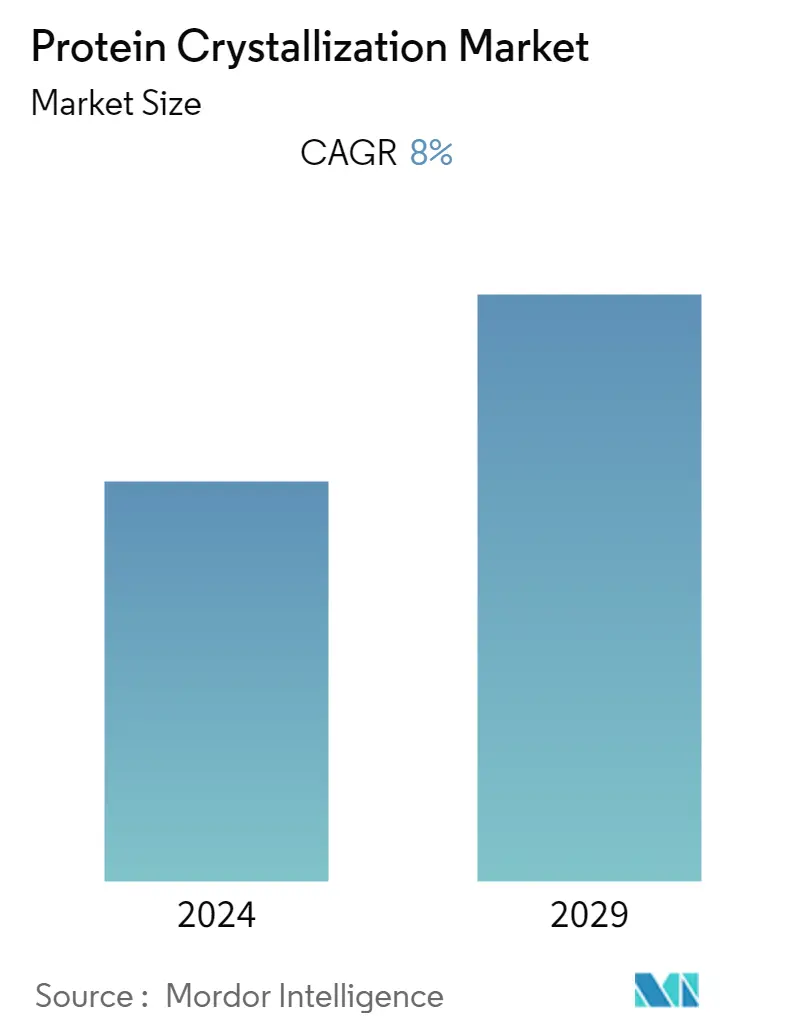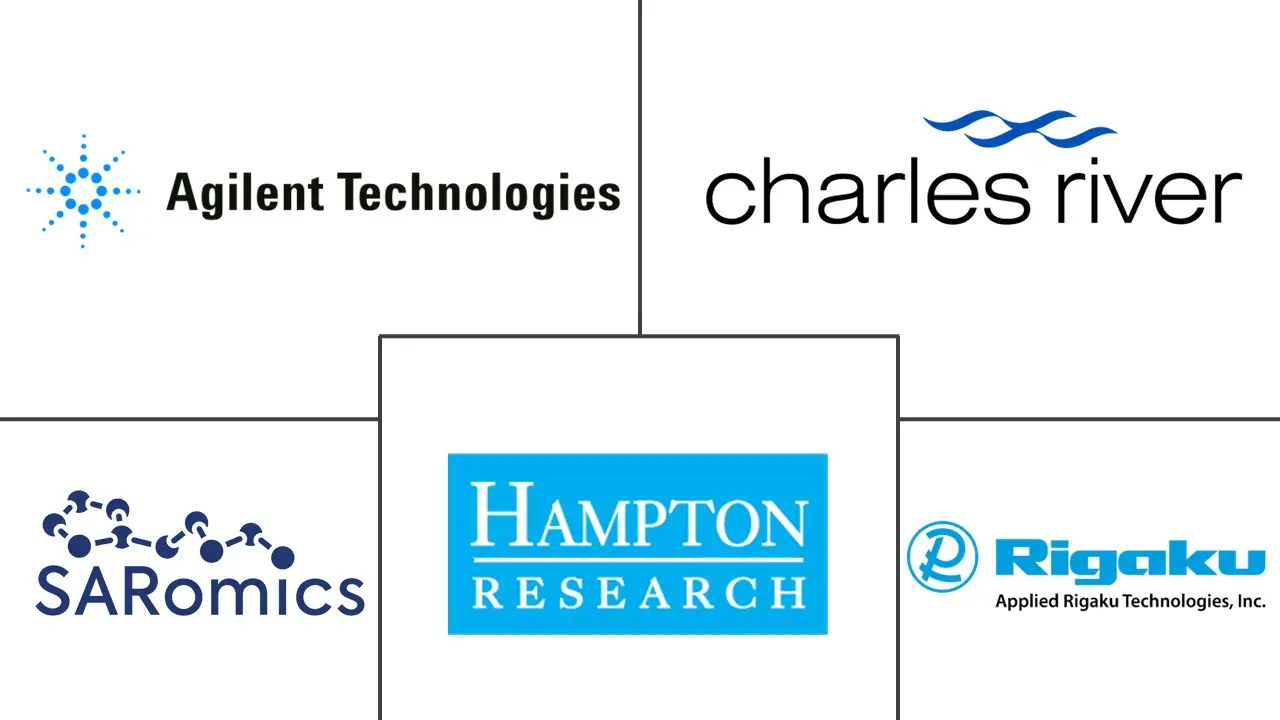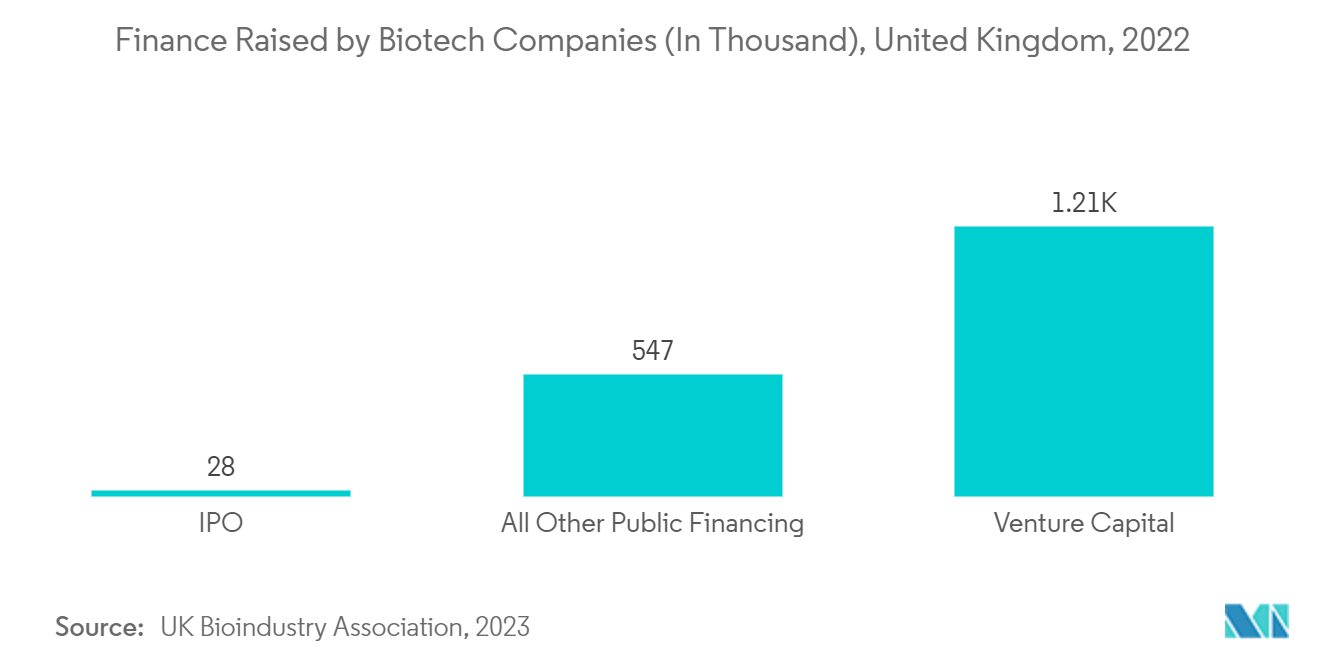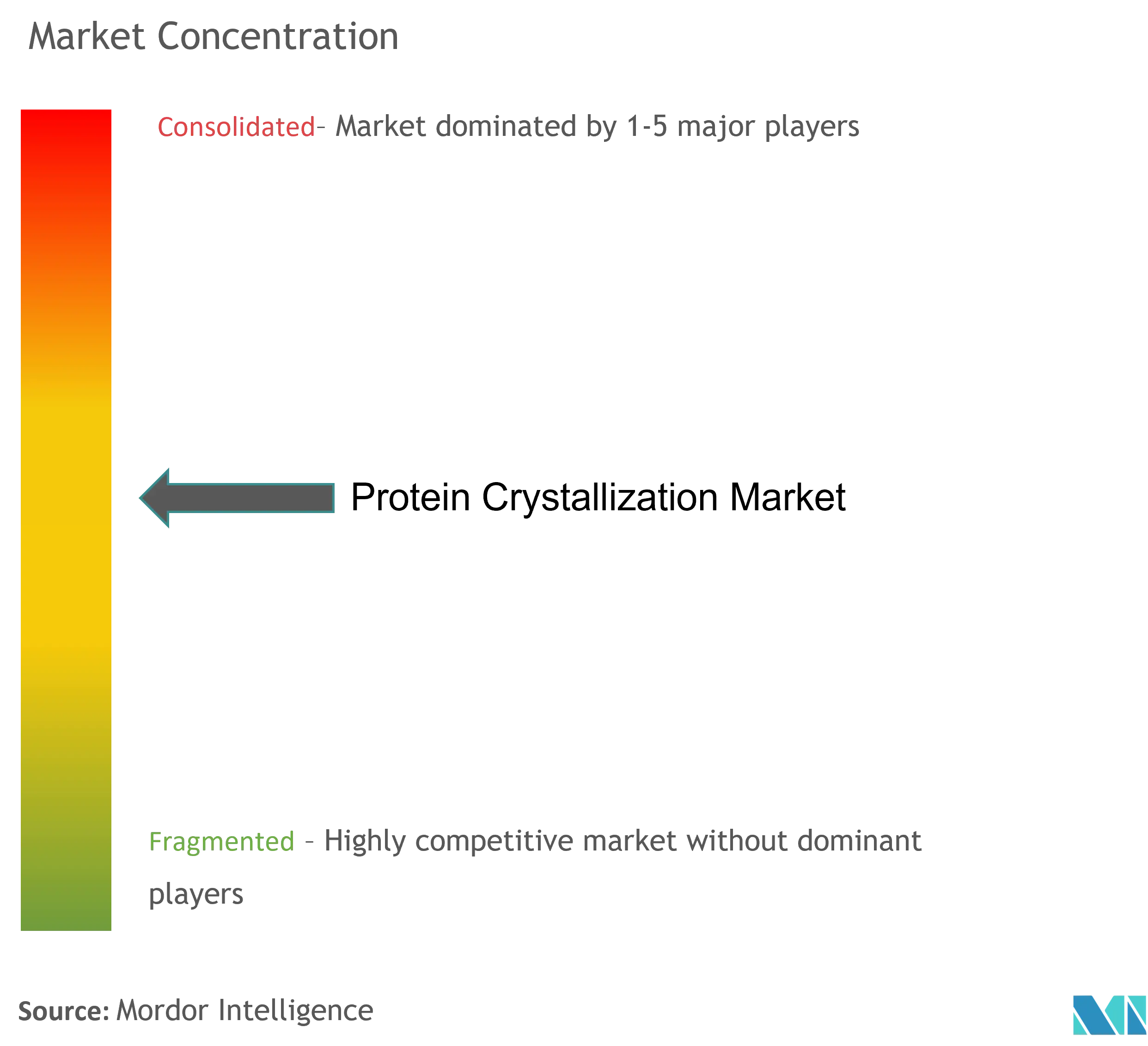Protein Crystallization Market Size

| Study Period | 2019 - 2029 |
| Base Year For Estimation | 2023 |
| Forecast Data Period | 2024 - 2029 |
| CAGR | 8.00 % |
| Fastest Growing Market | North America |
| Largest Market | Asia-Pacific |
Major Players
*Disclaimer: Major Players sorted in no particular order |
Protein Crystallization Market Analysis
The protein crystallization market is projected to register a CAGR of 8% during the forecast period.
COVID-19 significantly impacted the growth of the protein crystallization market as the rise in cases of infectious diseases among the population increased the demand for vaccines and protein-based therapies to overcome infection. The extensive use of protein crystallization to develop COVID-19 drugs has contributed to the market's growth. For instance, in January 2021, Elasmogen identified protein-based drugs to potentially stop COVID-19 infections through a partnership with the University of Minnesota. Thus, the agreement was signed between market players and the research institute with a focus on research for COVID-19 protein therapeutics, which created the need for protein crystallization. Therefore, during the initial pandemic, there was a slight decline in the studied market during the early pandemic due to supply chain restrictions and manufacturing delays. However, the market has gained traction due to increased demand for protein crystallization during the late pandemic. Furthermore, the market has attained a significant pace post-pandemic due to the increased development of antiviral drug development based on the data analysis of expression of genes, chemical structure, molecular pathway, and protein interaction mapping.
The factors driving the growth of the market include increasing investment in the research and development of biopharmaceuticals and increasing adoption of protein therapeutics.
The increasing demand for protein therapeutics is a key factor driving the market's growth. This is because protein therapeutics have become integral to the healthcare industry over recent years. Due to their low immunogenicity and specificity, protein therapeutics are extensively used to treat various major diseases, such as cancer. The increasing demand for protein-based drugs and therapeutics has led the manufacturers to implement growth strategies to gain the major market share, thereby increasing the market's growth. For instance, in January 2022, Amgen partnered with Generate Biomedicines to discover and create protein therapeutics for five targets across several therapeutic areas and multiple modalities. Such research and development activities create the need for protein crystallization products and services, thus driving the market's growth.
Furthermore, the increasing demand for protein therapeutics is due to the increasing prevalence of chronic disease and rising awareness regarding protein therapeutics' efficiency. According to the American Cancer Society 2023, it is estimated that 1,958,310 new cancer cases are projected to occur in the United States in 2023. Such a huge incidence of cancer in developed regions creates a need to develop novel and efficient drugs, and as protein crystallization is widely used in drug discovery and development, it is expected to propel the growth of the market.
Advancements in protein crystallography and the implementation of standard protocols create a lucrative opportunity for market growth. Increasing application fields and areas of protein crystallization for tailoring effective drug candidates contribute to the market's growth over the forecast period. For instance, in October 2022, the Tokyo Institute of Technology developed a new cell-free protein crystallization (CFPC) method that provides major developments in the field of structural biology, including direct protein crystallization. The technique enables the analysis of unstable proteins that cannot be studied using other conventional methods.
Thus, owing to the abovementioned factors such as rising advancements in protein crystallization, rising incidence of chronic diseases, and rising initiatives from the key market players is expected to show positive growth of the market studied over the forecast period. However, the lack of skilled professionals and the high cost of instruments may impede the growth of the market.
Protein Crystallization Market Trends
The Pharmaceuticals and Biotechnology Industries Segment is Expected to Hold a Significant Market Share in the Protein Crystallization Market
The pharmaceutical and biotechnology industries are expected to be the most lucrative segment, with extensive usage of protein crystallization in the production process. The pharmaceutical and biotech industry is expected to register significant revenue growth over the forecast period owing to the increasing application of protein crystallization in the drug discovery and development process, rising demand for protein therapeutics, and the fundraising of biotech companies.
The increasing number of innovative product launches to meet the growing demand is also expected to boost the market segment's growth. For instance, in July 2021, DeepMind signed a partnership with the European Molecular Biology Laboratory (EMBL) to create the most complete and accurate database of predicted protein structure models for the human proteome. The partnership aims to cover all ~20,000 proteins expressed by the human genome, and this data is to be freely and openly available to the scientific community. Additionally, in July 2022, Redwire Corporation reported that it would be developing new in-space manufacturing technology to provide novel and flexible services to grow small-batch crystals of protein-based pharmaceuticals and other key pharmaceutically relevant molecules for research and production. Such launches and developments are propelling the growth of the market.
Furthermore, the growing expansion of facilities by pharmaceutical and biotechnological companies to meet the increasing demand for protein crystallization is also boosting the growth of the segment. For instance, in March 2022, Flow Eighteen38, a protein sciences division created to facilitate and accelerate antibody characterization and protein purification projects, announced a EUR 5 million (USD 5.48 million) investment into its protein production and biophysical characterization capabilities and services from its parent company, CRO FairJourney Biologics S.A. Such initiatives taken by the market players help in the increased adoption of protein crystallization techniques, thereby propelling the growth of the market segment.
Thus, owing to the abovementioned factors, the market segment is expected to project growth over the forecast period.

North America is Expected to Hold a Significant Share in the Market and Expected to do Same in the Forecast Period
North America is expected to hold a significant share of the global market owing to technological innovations in protein crystallization and an increase in research and development activities in the biopharma sector. The robust growth of protein crystallization can be attributed to the increasing investment and funding activities for proteomics research and the development of structure-based drugs.
The increase in research and development activities and collaboration among the market players and research institutes contribute to the growth of the overall regional market. For instance, in January 2022, Cullinan Oncology Inc. collaborated with the Icahn School of Medicine at Mount Sinai ("Icahn Mount Sinai") to develop novel small-molecule immune modulators. The multi-year collaboration agreement will focus on optimising and developing oral protein degraders targeting hematopoietic progenitor kinase 1 (HPK1), a key regulator of immune cell activation and a high-priority target in immune oncology. Such research agreements create the need for these products for protein crystallization and thus are expected to propel market growth.
Furthermore, in October 2021, EQRx and Absci Corporation signed a partnership agreement to discover and develop next-generation protein-based drugs. As per the agreement, both organizations leverage Absci's Drug Creation technology for discovery and development activities and EQRx's clinical development expertise and commercial capabilities to advance next-generation, protein-based therapeutics across multiple therapeutic areas, including oncology and immunology.
Thus, the market is expected to grow in the North American region over the forecast period due to rising research and development of protein based drugs.

Protein Crystallization Industry Overview
The protein crystallization market is moderately competitive and consists of several major players. The factors owing to the competition include rising initiatives from the key market players such as launches and partnerships, among others. Some of the companies currently operating in the market are Rigaku Corporation, Hampton Research Corporation, SARomics Biostructures AB, Agilent Technologies Inc., Charles River Laboratories Inc., and others.
Protein Crystallization Market Leaders
-
Rigaku Corporation
-
Hampton Research Corp
-
SARomics Biostructures AB
-
Agilent Technologies Inc.
-
Charles River Laboratories Inc.
*Disclaimer: Major Players sorted in no particular order

Protein Crystallization Market News
- June 2023: Iktos entered a collaboration with Curreio, Inc. (Curreio), a Japanese company specializing in structural analysis of biomolecules using cryo-electron microscopy in Artificial intelligence for new drug design. In this collaboration, Iktos' de novo generative design technology combined with Curreio's state-of-the-art cryo-EM platform will help the rapid and cost-effective design of novel preclinical drug candidates for an undisclosed target.
- February 2023: Rigaku supplied two XtaLAB Synergy-ED Electron Diffractometers to the National Crystallography Service (NCS), United Kingdom, to extend its reach from microcrystals to nanocrystals analysis using electrons, which will expose many new opportunities to transform structural analysis.
Protein Crystallization Market Report - Table of Contents
1. INTRODUCTION
- 1.1 Study Assumptions and Market Definition
- 1.2 Scope of the Study
2. RESEARCH METHODOLOGY
3. EXECUTIVE SUMMARY
4. MARKET DYNAMICS
- 4.1 Market Overview
-
4.2 Market Drivers
- 4.2.1 Increasing Investment in the Research and Development of Biopharmaceuticals
- 4.2.2 Rising Adoption of the Protein Therapeutics
-
4.3 Market Restraints
- 4.3.1 Lack of trained Personnel
- 4.3.2 High cost of the Instruments
-
4.4 Porter's Five Forces Analysis
- 4.4.1 Bargaining Power of Suppliers
- 4.4.2 Bargaining Power of Buyers/Consumers
- 4.4.3 Threat of New Entrants
- 4.4.4 Threat of Substitute Products
- 4.4.5 Intensity of Competitive Rivalry
5. MARKET SEGMENTATION (Market Size by Value - USD)
-
5.1 By Technology
- 5.1.1 X-ray Crystallography
- 5.1.2 NMR Spectroscopy
- 5.1.3 Others
-
5.2 By Product
- 5.2.1 Instruments
- 5.2.2 Reagents or Consumables
- 5.2.3 Services and software
-
5.3 By End User
- 5.3.1 Pharmaceutical and Biotechnology Industries
- 5.3.2 Others
-
5.4 Geography
- 5.4.1 North America
- 5.4.1.1 United States
- 5.4.1.2 Canada
- 5.4.1.3 Mexico
- 5.4.2 Europe
- 5.4.2.1 Germany
- 5.4.2.2 United Kingdom
- 5.4.2.3 France
- 5.4.2.4 Italy
- 5.4.2.5 Spain
- 5.4.2.6 Rest of Europe
- 5.4.3 Asia-Pacific
- 5.4.3.1 China
- 5.4.3.2 Japan
- 5.4.3.3 India
- 5.4.3.4 Australia
- 5.4.3.5 South Korea
- 5.4.3.6 Rest of Asia-Pacific
- 5.4.4 Middle East and Africa
- 5.4.4.1 GCC
- 5.4.4.2 South Africa
- 5.4.4.3 Rest of Middle East and Africa
- 5.4.5 South America
- 5.4.5.1 Brazil
- 5.4.5.2 Argentina
- 5.4.5.3 Rest of South America
6. COMPETITIVE LANDSCAPE
-
6.1 Company Profiles
- 6.1.1 Rigaku Corporation
- 6.1.2 Hampton Research Corp
- 6.1.3 MiteGen LLC
- 6.1.4 Agilent Technologies Inc.
- 6.1.5 Art Robbins Instruments, LLC
- 6.1.6 SARomics Biostructures AB
- 6.1.7 Tecan Trading AG
- 6.1.8 Charles River Laboratories International, Inc.
- 6.1.9 Bruker Corporation
- 6.1.10 Corning Incorporated
- 6.1.11 Thermo Fisher Scientific
- 6.1.12 Creative Biostructure
- *List Not Exhaustive
7. MARKET OPPORTUNITIES AND FUTURE TRENDS
** Subject To AvailablityProtein Crystallization Industry Segmentation
As per the scope of this report, protein crystallization is the act and method of creating structured, ordered lattices for complex macromolecules. The most common reason for creating protein crystals is to support structural biology investigations via different techniques such as X-ray crystallography, NMR spectrometry, and others. It is also a method to produce pure, stable, solid dosage forms and several injected and infused therapeutics that are associated with protein crystals. The protein crystallization market is segmented by technology (X-ray crystallography, NMR spectroscopy, and others), product (instruments, reagents or consumables, and services and software), end-user (pharmaceutical and biotechnology industries and others), and geography (North America, Europe, Asia-Pacific, Middle East and Africa, and South America). The market report also covers the estimated market sizes and trends of 17 countries across major regions globally. The report offers values in USD for the above segments.
| By Technology | X-ray Crystallography | |
| NMR Spectroscopy | ||
| Others | ||
| By Product | Instruments | |
| Reagents or Consumables | ||
| Services and software | ||
| By End User | Pharmaceutical and Biotechnology Industries | |
| Others | ||
| Geography | North America | United States |
| Canada | ||
| Mexico | ||
| Geography | Europe | Germany |
| United Kingdom | ||
| France | ||
| Italy | ||
| Spain | ||
| Rest of Europe | ||
| Geography | Asia-Pacific | China |
| Japan | ||
| India | ||
| Australia | ||
| South Korea | ||
| Rest of Asia-Pacific | ||
| Geography | Middle East and Africa | GCC |
| South Africa | ||
| Rest of Middle East and Africa | ||
| Geography | South America | Brazil |
| Argentina | ||
| Rest of South America |
Protein Crystallization Market Research FAQs
What is the current Global Protein Crystallization Market size?
The Global Protein Crystallization Market is projected to register a CAGR of 8% during the forecast period (2024-2029)
Who are the key players in Global Protein Crystallization Market?
Rigaku Corporation, Hampton Research Corp, SARomics Biostructures AB, Agilent Technologies Inc. and Charles River Laboratories Inc. are the major companies operating in the Global Protein Crystallization Market.
Which is the fastest growing region in Global Protein Crystallization Market?
North America is estimated to grow at the highest CAGR over the forecast period (2024-2029).
Which region has the biggest share in Global Protein Crystallization Market?
In 2024, the Asia-Pacific accounts for the largest market share in Global Protein Crystallization Market.
What years does this Global Protein Crystallization Market cover?
The report covers the Global Protein Crystallization Market historical market size for years: 2019, 2020, 2021, 2022 and 2023. The report also forecasts the Global Protein Crystallization Market size for years: 2024, 2025, 2026, 2027, 2028 and 2029.
Global Protein Crystallization Industry Report
Statistics for the 2024 Protein Crystallization market share, size and revenue growth rate, created by Mordor Intelligence™ Industry Reports. Protein Crystallization analysis includes a market forecast outlook to for 2024 to 2029 and historical overview. Get a sample of this industry analysis as a free report PDF download.



